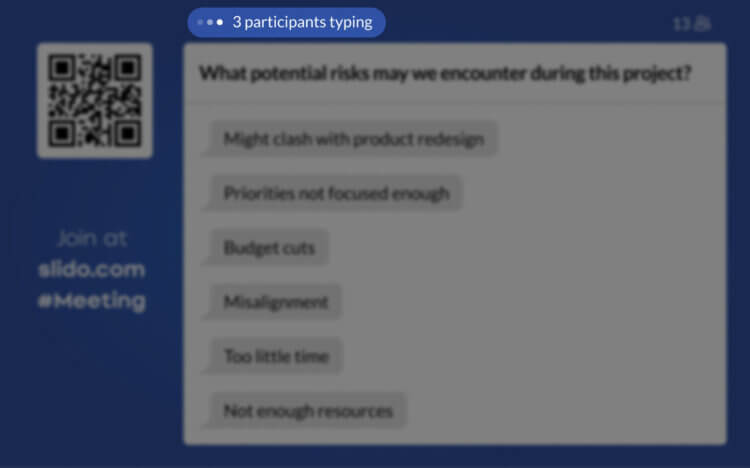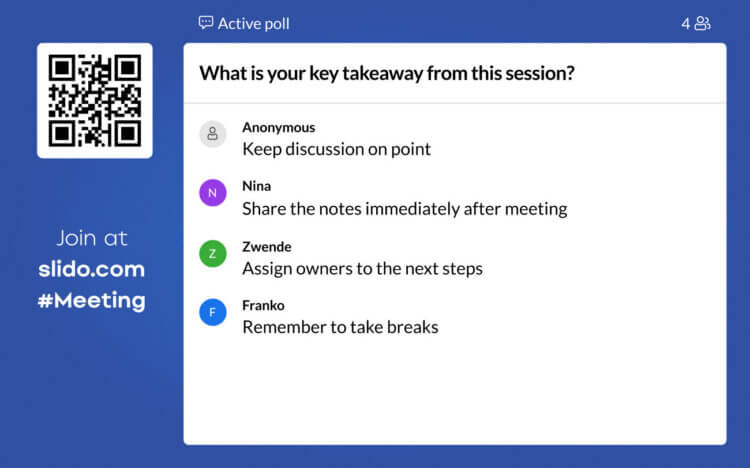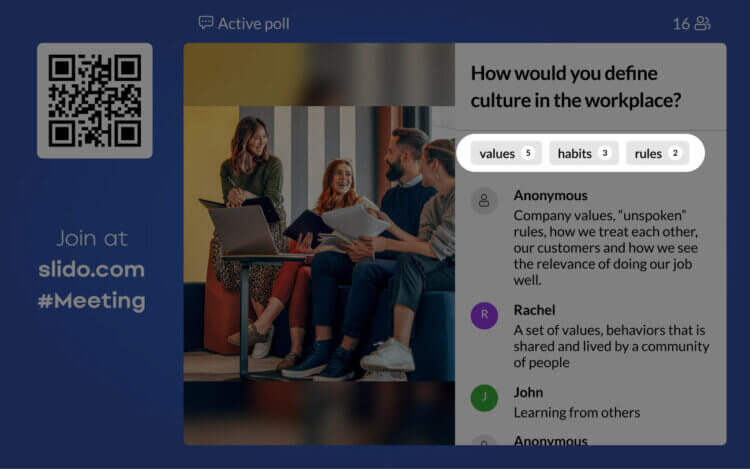Have you ever wondered how we make product decisions at Slido? In this blog, we’re going to show you how we improved the product to address a top pain point of our users: awkward silences.
Between our Product and User Research teams, we often deep-dive into the pain points and feature requests from our users to identify the fundamental need or problem they’re trying to solve.
Surprisingly, the ideal solution to these problems can look vastly different from the initial feature requests we receive.
Let’s take a look at one of the top three feature requests for Slido: Music in polls!
To add music or not?
By speaking to our users about this feature request, we learned that they were trying to deal with awkward silences while waiting for participants to vote.
Barely two years into the world of hybrid working, we’re still struggling when it comes to including the remote audience. It’s much harder to get a conversation going when half of your participants are not in the room. From this perspective, awkward silences are all the more challenging for those who moderate or facilitate hybrid meetings.
Silence can have a huge impact on the presenter’s confidence when facilitating interaction. In fact, over 34.5% of our users pointed to awkward silences as a key challenge while using Slido*.
As meeting organizers, we tend to see a lack of activity or awkward silences as:
- Participants not being engaged in the meeting
- The meeting content is too complicated to understand
- People feel uncomfortable interacting or speaking up
But, how do the meeting participants feel? And that’s exactly where we looked next.
Awkward silence: friend or foe?
Compared with meetings where people share their ideas out loud, a Slido-assisted meeting has a higher chance of removing participants’ fear of speaking up.
When combined with anonymity, Slido can help encourage the participants to share their unique perspectives or out-of-the-box ideas they may otherwise hold back for fear of being wrong or going against popular opinion.

However, for this level of engagement to take place, we need to provide the right amount of headspace for our meeting participants to think through the content that’s being presented. In such scenarios, silence is not a problem to be solved, but a tool to be leveraged.
While music in polls seems like the obvious solution to quell awkwardness for presenters, it clearly doesn’t improve the participant experience. Over 56% of the users who spoke to us during the research felt the same*.
Instead of filling the awkward bits with music, we asked ourselves how could we aid the facilitation of them for presenters? As a result, we’ve introduced the following features in 2022 to enable them to create better, smoother facilitation experiences.
1. The Typing Indicator
Whether you’re leading a strategic goal-setting meeting or bonding over a fun word cloud, it’s hard to decide how long you should dwell on the poll responses. There’s always a chance of missing out on someone who is still typing their answers.
How do you decide when to move on to the next bit? The Typing Indicator was designed with this concern in mind. By displaying the exact number of participants who are still typing, this feature helps you facilitate the session in a much more seamless manner.

Instead of having distracting music or a timer, Typing Indicator enables you to hold inclusive sessions by giving your participants enough time to express their thoughts and letting you know exactly when to move on, thereby making your meetings more time-effective.
The positive feedback we received inspired us to also add it to our Word Clouds, Surveys, and Ranking Polls.
Next time you see someone typing, bring them into the conversation. You can say something like “I can see that 10 people are still typing, let’s give them one more minute before we dive into the discussion”. This pause is a great touchpoint to let people know how much you value your participants’ input.
2. Participant Names in Open Text Polls
As hosts and moderators, it’s easier for us to have a name attached to the answers so we can get a discussion going naturally. By enabling Participant Names in Open Text Polls, you will know exactly who’s willing to share more about their responses.

Participant Names can also be helpful during brainstorming sessions or retrospective meetings, so you can follow up on responses. But keep in mind that your participants may still choose to be anonymous, which brings the focus back to facilitation.
If you end up with mostly anonymous responses, we have found with our clients that this can indicate a lack of psychological safety, where people can fear being judged for their responses. This can be anything from fear of having an idea rejected, to receiving backlash for sharing criticism. In this scenario, treat those anonymous responses as an opportunity to build on participants’ trust.
Your role as a facilitator is key here in inspiring people to open up next time; acknowledge their inputs and expand on how you perceive them yourself, then open the discussion to the wider group.
Quick tip: If you have larger meetings, agree on the name format, eg. first name + surname
3. Topics in Open Text Polls
When moderating large-scale meetings like an all-hands or a panel discussion, you may receive too many responses and too little time to discuss them. What if you were able to identify the recurring themes in your poll responses?

We introduced Topics in Open Text Polls [Beta] to help you get an overview of the recurring themes and concerns coming through larger sets of responses, just like Topics in Q&A. With these filters, you’ll be able to offer a summary of all the relevant information regarding any specific recurring topic, offering as much transparency as possible.
For example, if you see the filter showing “hiring”, give the participants a brief overview of your hiring strategy for the short term and long term, addressing any immediate concerns.
It’s all about the little things
At Slido, we believe that great meetings form the very foundation of a great company culture. With every improvement we make in our product, we’re hoping to facilitate these conversations in a safe and productive manner, while giving everyone a voice.
When exploring the idea of music in polls, we realized that we wanted to create an intuitive meeting facilitation experience for our users. If you think about it, Participant Names and Topics in Open Text Polls, and the Typing Indicator are small changes.
But, when used in combination, these features can help you unlock new, meaningful ways to connect with your meeting participants and lead conversations organically. If you feel lost in between, always look to your audience for those subtle virtual cues, because some of them may be typing still.
Here’s a video from Slido Community to help you make the most of these features.
Feeling inspired? Here are 10 more tips for Great Meetings from Leanne Hughes, facilitator, and host of the First Time Facilitator podcast.
Next time you face awkward silence in a meeting, embrace it! Try the tips and let us know how it went.
Written with inputs from Anna Zubkov, User Experience Researcher.



